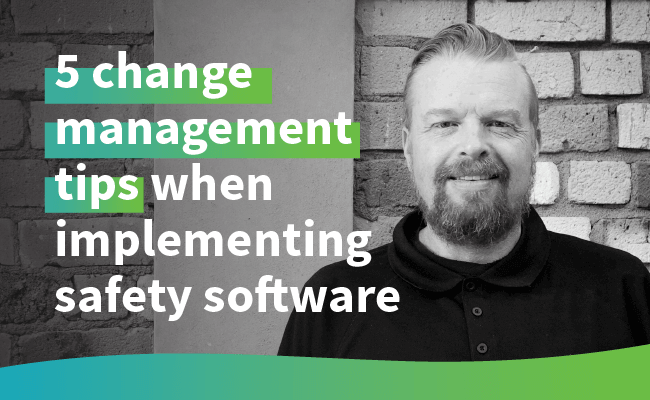23 July 2020
Change is inevitable for any organisation, and one of the most challenging processes organisations go through is implementing health and safety software. Jason McGeorge, Head of Client Success at ecoPortal explains
With the office politics, resistance to change, technical considerations, shifting processes and onboarding staff - well, installing new software systems can be challenging, to say the least. But adhering to a robust, formal change management process can minimise that short-term pain while enabling a dramatic improvement in performance.

Jason McGeorge, Head of Client Success at ecoPortal, has years of first-hand experience helping clients successfully invest in and apply health and safety management software. By using these 5 change management tactics, he says any organisation can achieve successful implementation and realise benefits that compound as time goes on.
Find your heart-string target
While it can be tempting to dive head-first into making changes, it’s important to take the time to understand how the changes will affect workers emotionally.
Start by defining how the investment will positively affect the health and safety of employees and the wider organisation. Then assess your organisation’s readiness for change based on its culture and the behaviour of employees.
Most people will understand the rationale behind the change, Jason says, but discovering the key emotional drivers will help you formulate a strategy that allows for better planning, more effective management, and smoother implementation. The trick is to focus on the positives.
“You want to be careful you’re not leveraging a bad situation, but instead finding that point where you can engage with your staff emotionally and get them to see the benefits of the change,” Jason explains.
Engage, engage, engage
Often health and safety managers have a great understanding of what a system needs to do but can forget the importance of how it will be used. Jason recommends involving staff at every level of the organisation throughout the whole life-cycle of implementation – especially if you’re implementing cloud-based software.
“The whole purpose of going cloud-based is accessibility, so there’s no value in having a system like that if your staff aren’t using it.”
By doing this it will be easier to understand what’s underpinning any resistance to change.
“One of the biggest challenges we see is fear of technology, particularly at the worker level. We go into a lot of places where the internet and mobile devices aren’t part of a normal day for some people – those issues can really stop any further engagement.”
Meaningful and effective communication is essential for strong teamwork, effective planning, and end-user involvement. The more extensively all staff understand the change, the more willing and able they’ll be to use the new system. Then, make sure training is readily available so employees know how the system works and how the new process relates to their day-to-day activities.
Lead by example
The foundation of any successful organisational change centres around the leadership team’s commitment to the change process. That might be standard best practice across any form of change management, but it’s also the one factor that can easily derail implementation of software, Jason explains.
“Lots of organisations are using technology to move away from traditional health and safety methodology – clipboards and checklists – and starting to lean more on creating an empowering health and wellness environment. Those that do that successfully are the ones who understand that it’s the behaviours displayed by the leadership team that create a wellness culture – not a piece of software.”
When there is consistent, managerial backing at every level, the entire workforce is driven toward accepting and adapting to the new system. Management should partake in the same training as all other staff members. Effective leadership like that will sharply reduce the behavioural resistance to change, especially when dealing with new technologies.
Facilitate a feedback loop
Depending on the size of your organisation, collecting feedback after the initial roll-out can seem overwhelming, but it’s key to identifying – and overcoming – change obstacles. People often respond favourably to knowing their input is being considered – even if their feedback is never implemented. It’s also important that any genuine system issues are addressed immediately to keep staff using the new tool.
“If you’ve got 5000 staff, how you collect, manage and respond to feedback can be your biggest challenge. We use micro or NPS surveys to manage volume and get an emotional response that’s a true representation of how staff members are feeling at the time they’re using the system. Alternatively, use your managers to channel and filter any feedback.”
The infinite loop of change management
Possibly the biggest misstep an organisation can make is assuming change management is a straight line.
“Change management is like the infinity symbol because it’s a constant cycle of reflection and review, assessing and adapting,” Jason says.
Change management is essential to any successful software implementation process. It can help prepare staff for the new system, reduce their resistance, and influence their attitudes ongoing. And while there are start and end points to implementation, change management merely facilitates the journey as opposed to imposing a step-by-step process.
Implementing change the right way
Organisations can spend lots of time and money implementing new technology, and using change management techniques they can make sure the investment is worth it. Before you make any changes, take the time to understand how the change will impact on end-users emotionally – not just in their jobs. Engage with staff at every level of the organisation, use the leadership team to set a precedent, and find a way to gather and respond to feedback. Then, predict what aspects will cause resistance to change and find ways to overcome them.
When you’re ready to plan the right health and safety software for your business, you can try a demo or get in touch with the team at ecoPortal.







